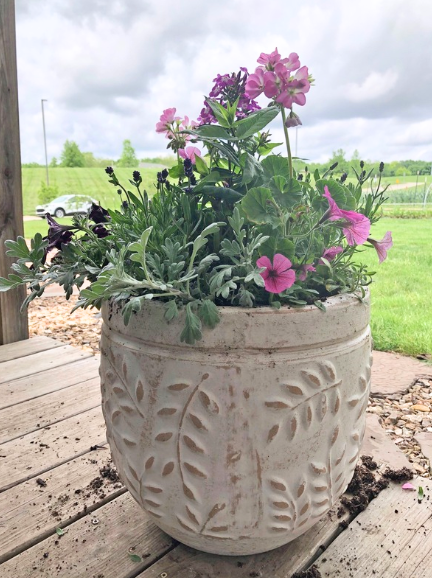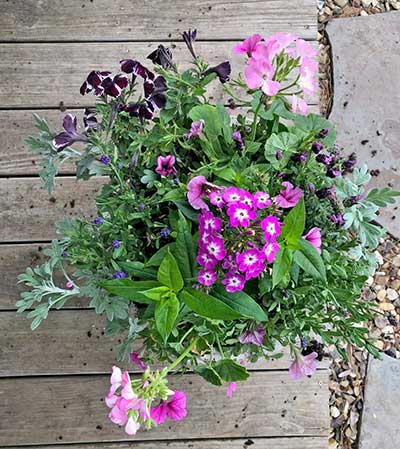Silver Clovers: Designing a Potted Flower Planter
This Silver Clovers class guides you through designing a potted flower planter. Watch the video above or read the article (or both!).

If you have recently walked through any of your garden centers, you have likely noticed the plethora of rainbowed selections available for purchase. Here are some pointers for those selections you are making, because there actually is a bit of science to designing planters that are appealing to the eye outside of just choosing pretty flowers.
Often when you hear people discussing flower planters, they will refer to the thriller, filler, and spiller.
Thrillers:
The thriller of the planter is intended to be the tallest plant of the mixture. In essence, it is a statement specimen whose purpose is to garner the initial attention of a viewer, making them want to see more. Picture a giant arrow of sorts signaling “Look at me!” to passersby— that is your thriller.
For my planter I selected a perennial tall phlox as a thriller. Reaching around 2 feet in height, this plant provides not only colorful flowers, but uniquely shaped flowers and its upright, gangly foliage differs from the rest of the plants being included, adding variety to what is being viewed.
Fillers:
The fillers of the plants, as the name suggests, fill empty space— but they are also the opportunity for incorporating mass amounts of color, shape, and leaf texture into your design.
For my fillers I am going with three plants:
- Lavender adds height, color, and softly textured leaves to the arrangement. Additionally, they incorporate a strongly desirable scent into the planter, appealing to more than just the visual senses.
- Geranium is my second filler. These add unique flowers, more color, and differently shaped round leaves.
- And then the old flower planter staple, petunias are an easy method for filling space that incorporates plenty of color, so I packed these into any leftover areas.
For this planter I used wave petunias which are meant to vine as well as fill, so in this case the plants will be both part filler and part spiller.
Spillers:
The spillers of the plant spill or trill over the edge of it, ultimately their purpose is to physically expand the surface area of actual plant material being viewed. Done correctly, this can double or triple the size of a plant display.
In addition to my wave petunias, I planted artemisia as my spiller. This plant adds a lighter contrasting color to the other plants incorporated, uniquely shaped leaves, desirable scent, and a physically soft look and texture.
Bringing it together:
When selecting plants to mix together, it's important to ask yourself” What unique factor is this plant contributing?
Then it is also best practice to make sure the selections are complimenting each other, and the easiest way to do this is by looking at color. Remember, if you wouldn't wear two colors together, they probably wouldn't look good in a planter together either. Try to avoid colors that clash.
Care requirements:
 Keep in mind that just because two plants look good together does not mean they will grow well together. Care requirements of all plants being incorporated should match.
Keep in mind that just because two plants look good together does not mean they will grow well together. Care requirements of all plants being incorporated should match.
For example, if you are making a full sun, moderate water planter like this one, then those needs should be the care needs for all of the plant specimens incorporated in order to maintain adequate plant health.
In my planter I did not leave much room available for plants to expand and grow. This is something that you can get away with in ornamental planters, but the practice should be best avoided if you're trying to get large, fully grown plants. While the plants are mixed together, they are technically still competing against each other for survival. Ultimately the plants in this planter will expand somewhat, but they will never be able to be huge due to this competition. In essence this close planting acts as a natural growth regulator, hopefully keeping the plants in uniform size relative to each other.
Finally, and most important:
Have fun with your planter design! This is your opportunity to get creative and draw out the artist in you, and incorporate that artist into your plant displays.
These tips followed, you'll have the showstopping planter of your dreams this growing season.
